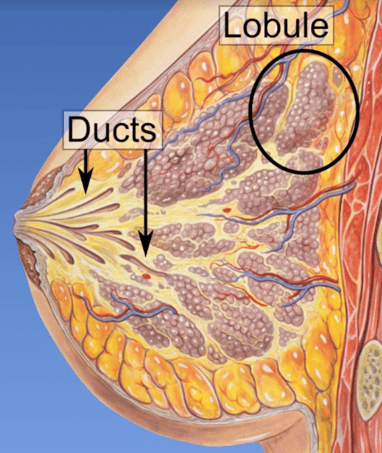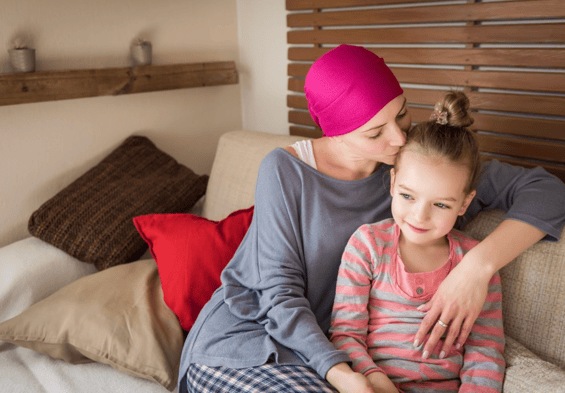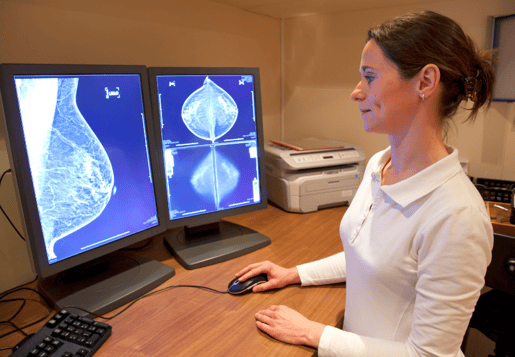Breast cancer: Symptoms, types, stages, and treatment in New Zealand
Breast cancer is a leading disease among women in New Zealand. Find out more about its types, symptoms, stages, treatment, and ways to lower one's risk.
Breast cancer is an abnormal growth that begins in the breast tissue. It may develop gradually, or it can be aggressive and spread very quickly.
In New Zealand, breast cancer is the most common cancer in females and a leading cause of death among women. Although rare, more than 20 Kiwi males are also diagnosed with breast cancer annually.
Early diagnosis and prompt treatment with effective medication increase the likelihood of a successful cancer outcome and can improve patients’ recovery and long-term survival rates. Most cancer treatment is free in New Zealand. But many public health facilities are stretched to breaking point, leading to long waiting times for diagnosis and therapy.
Some breast cancer patients currently wait two or three times the recommended period before they can see a specialist. Wait times for essential surgery have increased dramatically over the past decade. During the years 2003 to 2005, more than 55% of women with breast cancer had their first surgery within 31 days of diagnosis. Figures for 2018 to 2020 show that only 36% of women had received their first surgery in that 31-day window. Another example: in the years 2017 to 2021, about 6,000 women waited over 60 days to be offered a mammogram appointment. In some cases, this delay has stretched out to five months.
Many financial advisers regard health insurance as part of a sensible strategy for living in modern New Zealand. The experts at Policywise agree.

Health | Life | Trauma | Total and Permanent Disability | Income Protection
Learn more on different types of insurance from an expert licenced financial adviser and see what's best for your circumstances.

Learn more about different types of insurance from a licenced financial adviser and see what's best for your circumstances.
Health | Life | Trauma | Total and Permanent Disability | Income Protection
Early treatment is critical
When dealing with aggressive cancers, a delay in both diagnosis and treatment can allow cancerous cells to spread quickly, making recovery more challenging and the outcome less certain. If your breast cancer is detected through a mammogram - a process that can identify cancer cells when they are still extraordinarily tiny - you are 92% more likely to survive at least ten years or more. If your cancer is detected once a palpable lump is found - perhaps through manual examination - then that survival rate drops to 75%.
Some patients can afford access to rapid diagnostic tests, specialist appointments, and treatments by utilising private medical facilities. However, the associated costs of private breast cancer treatment in New Zealand can quickly deplete your savings and push you into debt.
Medical insurance shields you and your family from the financial burden of breast cancer and other serious illnesses. A Policywise adviser can help you compare health insurance plans and choose the best cover for this common disease. Our service is quick and completely free. All it takes is a chat to sort out a plan that offers you financial support and fast access to cancer treatment that can save your life. We recommend you schedule a 5-minute callback with Policywise today - you’ll be surprised at how easy it is to put your mind at ease.
How common is breast cancer in New Zealand?
Sadly, New Zealand has the 8th highest breast cancer incidence rate in the world. The statistics are stark:
- Breast cancer in New Zealand affects one in nine Kiwi women.
- It was diagnosed in 3,660 women in 2020, a 30% increase from 2010.
- Breast cancer kills more than 600 Kiwi women each year.
- The disease develops in around 25 Kiwi men each year.
- It’s more common in women aged over 50 (70% of diagnoses and 80% of deaths).
Maori women are 33 times and Pacific women 52 times more likely to die of breast cancer within ten years, compared to Pakeha.
Breast cancer warning signs
Early detection of breast cancer leads to better outcomes. Keep a lookout for the following changes - they may be early symptoms:
- A new lump, tissue thickening, or skin dimpling on your breast
- Rashes or itchy, burning feelings in the nipple area
- Pain in the breast or armpit
- Changes in breast size or shape
- Nipple changes such as discharge, peeling, or inversion.
If you show any of these signs, visit your doctor. Catching breast cancer in its early stages and getting immediate treatment can improve your chances of survival.
.webp?width=607&height=404&name=image-png-2%20(1).webp)
How do I know for sure it’s breast cancer?
Diagnosing breast cancer involves physical examination, diagnostic tests, and imaging such as mammograms. Mammograms can detect breast cancer in its early stages and are one of the first lines of defence against this disease.
Women aged 45 to 69 are eligible for a free mammogram every two years if they qualify for public health services in New Zealand and meet the following criteria:
- No breast cancer symptoms
- Not pregnant or breastfeeding
- Have not had a mammogram in the previous 12 months.
If you don’t qualify for free mammograms but do have health insurance, call your insurer or health insurance adviser to check if testing for breast cancer is included in your benefits.
If you currently don’t have health insurance and are interested in finding out more, book a 5-minute callback from one of our Policywise advisers. Our time with you is free, and we offer professional, unbiased advice on securing the best health insurance for your circumstances. We understand that prompt diagnosis, treatment, and specialist care significantly improve your chances of surviving breast cancer in New Zealand.
Diagnosing Breast Cancer
Physical exam
Your doctor will ask about symptoms and your medical history, and do a visual and manual examination of your breasts.
Diagnostic imaging
Diagnostic imaging such as a mammogram, ultrasound or magnetic resonance imaging (MRI) can help to detect lumps and other abnormalities in your breasts.
Diagnostic tests
Further exploration might be needed to determine the type of cancer and how far it has spread. Biopsies are performed to allow laboratory analysis of tissue samples from the lump. If the reports indicate cancer, then additional blood tests, liver scans, or bone scans will help determine whether the cancer is present in other organs.
Pathology tests such as hormone-receptor tests and HER2 tests can help determine how aggressive the cancer is and provide some indication of treatment options.
Types of breast cancer
There are two main types of breast cancer:
1. PRE-Invasive or STAGE 0
Mammograms can detect abnormal or cancerous breast cells long before you can feel the lumps with any physical examination. These cells are confined within the milk ducts and are known as DCIS (Ductal Carcinoma In Situ). At this point, they have not spread any further; however, the presence of DCIS indicates an increased risk of developing breast cancer later. Although most DCIS is benign, surgical removal is common.

Mikael Häggström, M.D. - Author info - Reusing images- Conflicts of interest: NoneMikael Häggström, M.D., CC BY 2.5 <https://creativecommons.org/licenses/by/2.5>, via Wikimedia Commons
2. Invasive or infiltrating breast cancer
Here, the cancer cells have spread from the ducts or lobules to the surrounding breast tissue. There are two main groups of invasive breast cancers:
- Invasive Ductal Carcinoma (IDC): This is the most common type. It originates in the cells lining the milk ducts, infects the surrounding breast tissue, and may spread to other body parts.
- Invasive Lobular Carcinoma (ILC): The cancer cells originate in the lobules, spread to nearby breast tissue, and may also reach other parts of the body. ILC can be hard to detect and is often more advanced by the time it’s found.
Other, rarer types of invasive breast cancer exist, such as inflammatory breast cancer or triple-negative breast cancer, however, these typically only make up about 1 to 5% of breast cancers in New Zealand.
The recommended treatment will depend on how far advanced the cancer is. This is measured in stages.
Stages of breast cancer
Breast cancers are classified in stages to indicate how far they have spread. Traditionally, doctors used the TNM scale to help select the optimal treatment plan. The TNM scale gives each cancer a score from 0 (least severe) to 4 (most severe) based on the following factors:
(T) - the size of the tumour
If the tumour is small, then there’s less chance it has spread and it’s easier to treat.
(N) - lymph nodes affected
Nodes with cancer cells are given a number indicating how much cancer is present–the higher the number, the greater the number of cancer cells.
(M) - how far the cancer has metastasised (spread)
This indicates whether cancer cells have migrated into lymphatic / blood vessels and then into other parts of the body.
Doctors now modify these scores with additional measures such as:
- Tumour grade–how similar to normal cells
- Hormone receptor expression–are oestrogen & progesterone influencing cancer growth?
- HER2 overexpression–is too much HER2 being produced?
- Genomic test results–may indicate presence of cancer in lymph nodes
This may mean that your tumour is either downgraded to a less severe rating or upgraded to a more severe rating. Stages 1 to 4 indicate invasive cancers.
The table below shows a very simplified overview of how staging works. Within each stage there are additional categories.
| Breast cancer stage | Size (T) | Cancer present in lymph nodes (N) | Spread to other parts of the body (M) |
1 |
Tumour smaller than 2 cms | No | No |
2 |
Tumour 2-5 cms | Possible | No |
3 |
Tumour larger than 5 cms | Yes | No |
4 |
Any size | Yes | Yes |
You might also see Grade (1, 2 or 3) mentioned. This is not the same as the stage measurement. A grade indicates how cancer cells appear under a microscope, contrasts them with normal, healthy breast cells and measures how quickly they are dividing and growing.
Breast cancer treatment
Treatment is most successful when breast cancer is caught in its early stages. If you have health insurance, contact your insurer or insurance broker as soon as possible and apply for pre-approval for your treatment.
If you don’t yet know enough about the benefits of health insurance and would like to learn more, we’d love you to book a free 5-minute callback with a Policywise adviser. We’ll help you (free of charge) choose a plan that gives you faster access to diagnostics, specialist care, and treatment.
That treatment begins once your medical team (specialist, surgeon, oncologist, pathologist, radiographer, and nurses) has reviewed your test results. Your doctor will explain why they might recommend one method or medicine over another or suggest other pathways. And though you might be feeling overwhelmed at this point, it’s important for you, as a patient, to understand your treatment options and the potential side effects of each medication.
It can be really helpful to bring a support person to your meeting to help you process this information.
Treatment options for breast cancer include the following:
- Surgery
- Chemotherapy
- Radiotherapy
- Hormone treatment/manipulation
- Targeted/biological therapy.
Surgery
Most treatment plans start with surgery. The type of surgery depends on the tumour’s size, its position in the breast, and other variables such as the patient’s preferences.
Breast-conserving surgery (partial mastectomy, lumpectomy)
Here, the aim is to remove the tumour and some of the healthy breast tissue around it (usually about 1 cm extra) to ensure that none of the cancer is left. A follow-up course of radiotherapy to treat any remaining cancer cells and prevent a recurrence is standard practice.
This type of surgery will probably change the size or look of the breasts. Patients can then explore reconstructive surgery and other options for a better cosmetic result. Many comprehensive health insurance covers will pay for breast reconstruction. If you would like some help connecting with an insurer who offers this support, Policywise provides clear, easy-to-understand medical plan comparisons so you can make the best decision for your needs. Book a free 5-minute callback with us to have a chat!
Mastectomy - full breast removal
There are two basic types of mastectomy.
- Simple (total) mastectomy: removes the breast tissue, skin, nipple, areola, and a few underarm lymph nodes.
- Modified radical mastectomy: removes the whole breast as well as a more extensive area of lymph nodes.
A mastectomy may be a better option when the breast cancer is recurrent, the tumour is already large, or the tumours are located in different parts of the breast. Some women may opt for full removal to avoid radiation treatment.
Removal of node tissue, as standard practice, provides invaluable insight into the cancer’s progression.
Your specialist may recommend additional treatments such as radiation therapy, chemotherapy, or hormonal therapy to destroy any remaining cancer cells and minimise the risk of recurrence.
Patients can opt to have a breast reconstruction immediately following a mastectomy or after completing all required treatments. Sometimes, this may involve reducing the size of the healthy breast to balance the reconstructed breast.
Recovery usually takes around three to four weeks, and during this time you won’t be able to do any heavy lifting.
Radiotherapy/radiation treatment
Radiotherapy is a highly localised treatment that uses radiation to destroy any remaining cancer cells. Radiotherapy courses take between four and six weeks. It’s frequently recommended as a follow-up after breast-conserving surgery but may also be required after a mastectomy where tumours are large or close to the chest wall.
You may experience some temporary side effects after radiation treatment, including:
- ‘Sunburn’ or peeling of skin in the affected area
- Swelling on or around the breast
- Extreme tiredness
- Sore throat or difficulty swallowing.
Other patients experience side effects months or years after radiotherapy, such as lymphoedema, permanent weakness, pain, or numbness in the arm, changes in breast feel, shape, size, or colour, and a higher risk of heart disease.
Chemotherapy
‘Chemo’ medications aim to destroy any cancer cells still spreading in the body and can help minimise the risk of a recurrence. The treatments are given in cycles and take between three and six months to complete.
Typically, chemotherapy may be recommended for patients who have:
- Aggressive types of breast cancer
- Cancer cells in their axillary (armpit) lymph nodes
- Large tumours.
Chemotherapy drugs are powerful, and potential side effects will vary depending on the medications involved. Your body’s ability to fight off infections can be affected by the cytotoxic nature of chemotherapy, so you’ll have to be extra careful to protect yourself from other diseases.
Common side effects include:
- Nausea and loss of appetite
- Diarrhoea
- Hair loss
- Tiredness
- Mouth sores.

Targeted therapy
These drugs target cancer cells and are less likely to severely damage healthy cells. They work by inhibiting cancer cell growth and encouraging the immune system to fight cancer cells.
The choice of drugs available to women fighting breast cancer in New Zealand is limited. Pharmac funds some drugs, such as Trastuzumab (Herceptin), but private health insurance can give you access to a greater range of non-Pharmac-funded drugs from overseas.
Hormone therapy
Some breast cancers use the naturally-occurring hormones oestrogen and progesterone to speed up their growth. Hormone therapy shrinks or slows down cancer growth by decreasing hormone production or blocking the hormones from attaching to breast cancer cell receptors.
Hormone therapy can be used:
- Before surgery to shrink the tumour
- After surgery to reduce the risk of recurrence
- To slow down cancer growth in patients who can’t have surgery due to major medical issues
- Where cancer has spread to other parts of the body (also called secondary, metastatic, or advanced breast cancer).
Side effects of hormone therapy vary, depending on the specific medication you take. Some of these side effects might include:
- Increased risk of osteoporosis
- Permanent menopause
- Hot flushes, mood swings, and other menopausal symptoms
- Tiredness and muscle pain
- Vaginal dryness
- Impotence in male breast cancer patients.
Are you prepared for life’s uncertainties?
You may not have breast cancer, and it may not run in your family, but that’s no guarantee it won’t happen to you or someone you love. Think about how health insurance could cover you for that possibility. But please realise that not all health insurance plans are the same. Some plans only pay for a tiny fraction of your cancer treatment expenses.
Don’t let this happen to you. When buying health insurance, ask your insurance adviser about policies that include cancer cover. Make sure you consider maximum benefit amounts for treatments, non-Pharmac cover, inclusions, and any exclusions.
The team at Policywise are insurance specialists. We’ll help you identify maximum benefit amounts for treatments, non-Pharmac cover, inclusions, and any exclusions. We provide clear, easy-to-understand plan comparisons from different insurers so you can choose the plan with the best cancer cover; it’s a service we provide 100% free of charge.
We can also help you identify health insurance policies which include additional consultations with specialists who can offer second opinions and supplementary advice about your treatment plans. That’s priceless when dealing with all the questions that will undoubtedly come up over time.
Schedule a 5-minute callback with a Policywise expert and talk to us today - so we can help you navigate the future.
Cost of chemotherapy and other breast cancer treatments in New Zealand
Delaying breast cancer diagnosis and treatment allows the cancer to progress. As it grows and spreads, treatment or control becomes more difficult, lowering your chance of surviving longer or having a normal life.
Cancer treatments in New Zealand’s public hospitals are free. But some patients opt to go to private facilities to avoid ever-longer waiting times for treatments or to access non-Pharmac- funded drugs from overseas.
If you don’t have medical insurance, then private treatment costs can be significant. Have a look at the table below:
Private treatment costs in New Zealand
| Chemotherapy drugs not founded by Pharmac | $15,000-$150,000 |
| Radiotherapy | Up to $55,000 |
| Mastectomy with breast reconstruction | Up to $100,000 |
| Everolimus (Afinitor) (non-Pharmac funded targeted medicine) (non-Pharmac funded targeted medicine) | Around $26,000 per 30 tablets, to be taken for as long as deemed necessary by your doctor |
| Nab-paclitaxel (Abraxane) (non-Pharmac funded chemotherapy drug) | Around $2,700 per 100mg; given once every three weeks; exact dosage and number of cycles will be determined by your doctor5 |
Some New Zealand breast cancer patients use their savings, take out loans, explore cost-share programmes, or turn to fundraising campaigns to pay for these treatments. You don’t have to resort to these desperate measures if you plan ahead.
Health insurance–a better solution for you
Now is the time to think about investing in a private health insurance plan that will give you or someone you love the best treatment in the event of a cancer diagnosis. How about having a 5-minute phone conversation with us? We can then schedule a chat about insurance plan comparisons and quotes, so together, we can find the best path towards securing your financial and physical health.
To find you the perfect cover, we’ll need to ask you a few questions about your situation. This is easy for you to do over the phone and only takes five minutes unless you’ve got lots of questions, which we’re happy to answer. And this service is absolutely free to you.
It’s also different from generic, online comparison sites. Some insurance providers price differently based on things like BMI or existing health conditions. Comparison sites cannot check these variables automatically, so they ignore them. They also can’t check that the policies they suggest will accommodate pre-existing conditions, or cover non-funded drugs. It all adds up to you paying more than they said you would.
This is what makes our quote comparisons 100 times more accurate than generic instant-results comparison sites. The quotes we provide will be exactly the same as if you’d gone to the insurer directly, but we do all the work for you, completely free of charge.
We can also take care of lodging any claims on your behalf. That way, you can focus on living life to the fullest. We don’t charge you anything for this service - you won’t pay a cent extra.
With medical insurance, you can:
- Get faster access to diagnostic exams and expensive treatments
- Pay for non-Pharmac-funded drugs and their administration costs
- Cover other hospital expenses.
Some life insurance plans also provide lump-sum payments to terminally ill policyholders. Income protection insurance gives you peace of mind about being able to pay the bills. Patients can use these funds to pay for medical and household expenses, make up for lost income or relax and enjoy more quality time with their loved ones.
To find out more about health insurance plans that include cancer cover, schedule a call with a Policywise adviser today - it’s quick, easy, and 100% free.
What causes breast cancer & what’s the risk?
The exact causes of breast cancer are unknown. But there are a number of risk factors linked to breast cancer. Some you can change to reduce your risk of breast cancer and some risk factors are beyond your control.
Risk factors you can’t control or change include:
- Age (being 50 years old or above)
- Inheriting a BRCA (breast cancer) gene mutation
- Previous history of breast cancer
- Family history of breast cancer–accounts for 5 to 10% of cancers
- Race or ethnicity–certain ethnicities are more likely to develop breast cancer
- Excessive radiation exposure (chest X-Rays) especially when young
- Length of exposure to oestrogen
Fortunately, there are some risk factors that you can control and change.
These include:
- Poor diet, high in fat and low in fibre, vegetables and fruit
- Being overweight and not exercising regularly
- Consuming alcohol
- At risk people using particular medications such as oral contraceptives
If these risk factors speak to you, maybe it’s time to take charge of your health. Reducing or eliminating these risk factors can significantly reduce your risk of developing breast cancer.
Breast cancer myths
The following factors do not increase your risk of developing breast cancer:
- Underwire bras or carrying a mobile phone next to your breasts
- Breast implants, breast injury or nipple piercings
- Underarm antiperspirants/deodorants
- In vitro fertilisation procedures or having an abortion
Breast cancer screening in NZ
Early detection and treatment increase the odds of beating breast cancer. Under New Zealand’s national screening program, women aged 45 to 69 are eligible for a free mammogram every two years.
If you’re younger than 45 years old and in a high-risk group, you should ask your doctor about breast screening options.

What happens after breast cancer treatment
Follow-ups
After completing your treatment, you will have regular follow-up visits with specialists such as surgeons, oncologists, GPs, and physiotherapists. These visits will involve monitoring procedures such as diagnostic imaging and blood tests.
You should check your breasts or mastectomy area regularly and inform your doctors about any abnormal symptoms.
You may also opt to see professional counsellors to help you cope with the emotional impact of your breast cancer diagnosis and treatment.
Note that some health insurance plans include follow-up consultations and mental health cover - Policywise can advise you on this. Knowing you can have faster access to these services without worrying about lengthy wait times or costs reduces your stress. It can help you focus on your health and get all the support you need for your recovery.

Will breast cancer return?
The risk of your breast cancer recurring depends on factors such as your age, the stage your cancer was diagnosed at, and how aggressive it was.
If you’d like to lessen the stress of dealing with the possibility that your breast cancer might return, Policywise can help. We’ll source a medical insurance plan that reimburses the cost of your breast cancer screening and treatment, lifting that particular financial and physical worry off your shoulders.
It makes sense to be prepared for breast cancer - or any other cancer - by considering the benefits of taking out private health insurance. Your options are so much better with the provision of a quicker and possibly more comprehensive medical service than the public health system can supply.
At Policywise, we take the time to understand your needs and concerns. Book your 5-minute callback now. It’s fast, and it’s 100% free.
Disclaimer: This article is for general information only. Nothing in this blog or on this website is intended as medical, dietary, or financial advice. Although we aim to update our content regularly, you are advised to consult a Policywise adviser, health professional, or an appropriate specialist before acting on any information herein. They can factor in your personal circumstances or preferences and help guide your decision-making process.
Quickly find the cover that’s best for you
Policywise tells you which health, life or disability insurance best matches your circumstances, 100% free. Talk to one of our insurance advisers to find out which health or life insurance is best for breast cancer, and other serious illnesses.
References
- “Breast Cancer in New Zealand.” Breast Cancer Foundation NZ, https://www.breastcancerfoundation.org.nz/breast-awareness/breast-cancer-facts/breast-cancer-in-nz. Retrieved 6/09/2022
- “Breast Cancer.” Ministry of Health NZ, https://www.health.govt.nz/your-health/conditions-and-treatments/diseases-and-illnesses/breast-cancer. Retrieved 6/09/2022
- Breast Cancer Stages, https://www.breastcancer.org/pathology-report/breast-cancer-stages. Retrieved 6/09/2022
- UK, Cancer Research. “Breast Cancer Stages, Types and Grades.” Stages, Types & Grades of Breast Cancer | Cancer Research UK, 21 July 2020, https://www.cancerresearchuk.org/about-cancer/breast-cancer/stages-types-grades Retrieved 7/09/2022
- Abraxane. Medsafe. (2018, May). https://www.medsafe.govt.nz/Consumers/CMI/a/Abraxane.pdf Retrieved 6/09/2022
- Abraxane Prices, Coupons and Patient Assistance Programs. Drugs.com. https://www.drugs.com/price-guide/abraxane Retrieved 6/09/2022
- Access to New Medicines. Breast Cancer Aotearoa Coalition. (2022, July 21). https://www.breastcancer.org.nz/AboutBC/Treatment/Access-new-medicines Retrieved 5/08/2022
- Afinitor. Medsafe. (2021, July). https://medsafe.govt.nz/Consumers/cmi/a/afinitor.pdf Retrieved 3/07/2022
- AIA Health: Health Insurance. AIA. https://www.aia.co.nz/content/dam/nz/en/docs/our-products/brochures/aia-health-insurance.pdf Retrieved 3/03/2022
- Official Information Act (1982) Request. Te Whatu Ora Counties Manukau. (2018, September). https://www.countiesmanukau.health.nz/assets/Official-Information-Act/0188ed017d/OIA-08082018-MARTIN-Cancer-Surgical-Wait-times.pdf Retrieved 1/08/2022
- Breast Cancer in New Zealand. Breast Cancer Foundation NZ. (n.d.). https://www.breastcancerfoundation.org.nz/breast-awareness/breast-cancer-facts/breast-cancer-in-nz Retrieved 23/08/2022
- Breast Cancer Myths vs. Facts. Breastcancer.org. (n.d.). https://www.breastcancer.org/symptoms/understand_bc/myths-facts Retrieved 23/08/2022
- Breast Cancer Stages . Breastcancer.org . (n.d.). https://www.breastcancer.org/symptoms/diagnosis/staging Retrieved 23/08/2022
- Breast Cancer Staging. Breast Cancer Foundation NZ. (n.d.). https://www.breastcancerfoundation.org.nz/breast-cancer/tests-and-diagnosis/breast-cancer-staging Retrieved 12/08/2022
- Breast cancer statistics. World Cancer Research Fund International. (n.d.). https://www.wcrf.org/cancer-trends/breast-cancer-statistics/ Retrieved 23/08/2022
- Breast Cancer Survival Laid Bare in New Report: Māori, Pasifika and Younger Women Most at Risk. New Zealand Doctor. (2022, February 4). https://www.nzdoctor.co.nz/article/undoctored/breast-cancer-survival-laid-bare-new-report-maori-pasifika-and-younger-women Retrieved 12/07/2022
- Breast Cancer - Symptoms, Diagnosis, Treatment. Southern Cross. (n.d.). https://www.southerncross.co.nz/group/medical-library/breast-cancer-symptoms-diagnosis-treatment Retrieved 23/08/2022
- Hormonal Therapy. Breast Cancer Foundation NZ. (n.d.). https://www.breastcancerfoundation.org.nz/breast-cancer/treatment-options/hormonal-therapy Retrieved 23/08/2022
- How Much Does Afinitor Cost Per Month? Drugs.com. (n.d.). https://www.drugs.com/medical-answers/afinitor-cost-month-3539995/ Retrieved 2/07/2022
- Invasive Breast Cancer. Breast Cancer Foundation NZ. (n.d.). https://www.breastcancerfoundation.org.nz/breast-cancer/types-of-breast-cancer/invasive Retrieved 2/08/2022
- Invasive Breast Cancer (IDC/ILC). American Cancer Society. (n.d.). https://www.cancer.org/cancer/breast-cancer/about/types-of-breast-cancer/invasive-breast-cancer.html Retrieved 2/08/2022
- Lobular Carcinoma in Situ (LCIS). American Cancer Society. (n.d.). Retrieved from https://www.cancer.org/cancer/breast-cancer/non-cancerous-breast-conditions/lobular-carcinoma-in-situ.html 2/008/2022
- Mastectomy. Breast Cancer Foundation NZ. (n.d.). https://www.breastcancerfoundation.org.nz/breast-cancer/treatment-options/surgery/mastectomy Retrieved 2/08/2022
- New Cancer Registrations 2019. Ministry of Health. (2021, December 17). https://www.health.govt.nz/publication/new-cancer-registrations-2019 Retrieved 3/08/2022
- New Zealand. The Global Cancer Observatory. (2021, March). https://gco.iarc.fr/today/data/factsheets/populations/554-new-zealand-fact-sheets.pdf Retrieved 23/08/2022
- Newman, T. (2021, October 7). 15 Breast Cancer Myths Busted. Medical News Today. https://www.medicalnewstoday.com/articles/medical-myths-15-breast-cancer-misconceptions Retrieved 1/07/2022
- Pre-Invasive Breast Cancer. Breast Cancer Foundation NZ. (n.d.). https://www.breastcancerfoundation.org.nz/breast-cancer/types-of-breast-cancer/pre-invasive Retrieved 1/04/2022
- Quinn, R. (2020, February 19). Breast cancer diagnoses delayed as wait times Blow Out. RNZ. https://www.rnz.co.nz/news/national/409873/breast-cancer-diagnoses-delayed-as-wait-times-blow-out Retrieved 1/04/2022
- Radiation Therapy. Breast Cancer Foundation NZ. (n.d.). https://www.breastcancerfoundation.org.nz/breast-cancer/treatment-options/radiation-therapy Retrieved 2/4/2022
- Receptor Status. Breast Cancer Foundation NZ. (n.d.). https://www.breastcancerfoundation.org.nz/breast-cancer/types-of-breast-cancer/hormone-receptor-status Retrieved 2/04/2022
- Targeted Therapy. Breast Cancer Foundation NZ. (n.d.). https://www.breastcancerfoundation.org.nz/breast-cancer/treatment-options/targeted-therapy Retrieved 1/07/2022
- Wellington Health Boards Review 52 Breast Cancer Cases over Mammogram Delays. RNZ. (2022, May 24). https://www.rnz.co.nz/news/national/467798/wellington-health-boards-review-52-breast-cancer-cases-over-mammogram-delays Retrieved 2/08/2022
ON THIS PAGE
Download our insurance comparison chart
We need a few details before we can send you this content…
* All fields are required

